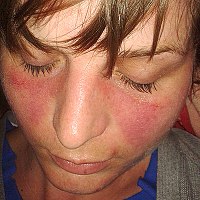
Photo from wikipedia
BACKGROUND Cutaneous lupus erythematosus (CLE), occurring with or without systemic lupus erythematosus (SLE), is a group of inflammatory skin diseases that can be very debilitating, causing significant psychological distress, and… Click to show full abstract
BACKGROUND Cutaneous lupus erythematosus (CLE), occurring with or without systemic lupus erythematosus (SLE), is a group of inflammatory skin diseases that can be very debilitating, causing significant psychological distress, and sometimes scarring. OBJECTIVES We sought to comprehensively present the evidence for different treatment modalities in patients with cutaneous manifestations of lupus erythematosus (LE). METHODS Medline, Embase, Scopus and Cochrane CENTRAL were searched electronically from 1990 to March 2019, using keywords related to cutaneous lupus and synonyms and treatment. Articles retrieved were screened for relevance, including reference lists of retrieved reviews. We included clinical trials, observational studies or case series with ≥5 patients focussing on treatment of CLE, with or without SLE. RESULTS The search identified 6637 studies, of which 107 were included. Each study commonly included a heterogeneous mixture of CLE subtypes, with or without SLE. The 107 included studies investigated 11 different categories of treatment in 7343 patients. Treatments included topical calcineurin inhibitors (13 studies), sun protection (5 studies), R-salbutamol cream (2 studies), antimalarials (22 studies), synthetic DMARDs (10 studies), retinoids (2 studies), thalidomide/lenalidomide (22 studies), biologic therapies (15 studies), intravenous immune globulin (3 studies), laser (6 studies) and other therapies (7 studies). General measures to be considered include smoking cessation, sun protection measures and optimisation of vitamin D levels. Moderate evidence exists for benefit with topical CNIs, particularly as a steroid sparing agent in areas at high risk of steroid complications (e.g. facial skin). There is moderate evidence for hydroxychloroquine, which is first-line in SLE patients, limited evidence to support other synthetic DMARDs, and moderate evidence supporting thalidomide but with significant risk of toxicity. Of biologic therapies, there are moderate data to support belimumab. Limited evidence exists for other therapies. CONCLUSION Many management options are available for CLE, including topical, systemic and biologic therapies, with a variable balance of efficacy and toxicity. There is a paucity of high-quality clinical trial data. Further trials are required to better understand optimal management of CLE, particularly in specific subgroups.
Journal Title: Seminars in arthritis and rheumatism
Year Published: 2019
Link to full text (if available)
Share on Social Media: Sign Up to like & get
recommendations!